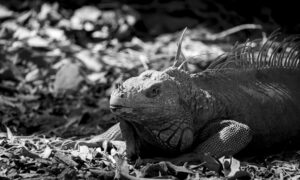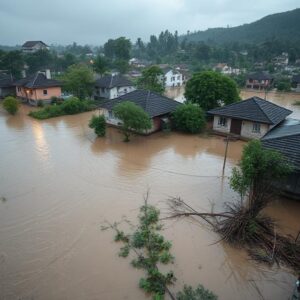The Komodo dragon (Varanus komodoensis) is the largest living species of lizard, native exclusively to a few Indonesian islands including Komodo, Rinca, Flores, and Gili Motang. These islands form the core of the Komodo dragon’s habitat within the Lesser Sunda Archipelago, a remote and protected area that supports their survival.
Physical Characteristics
- Size: Adult Komodo dragons can reach lengths of up to 3 meters (10 feet), with males typically larger than females. They weigh around 70 kilograms (154 pounds), though some individuals have been recorded at over 100 kilograms (220 pounds).
- Color: Their skin is rough and durable, covered with armored scales that are usually grayish-brown. Younger dragons may have brighter yellow or green bands and patches.
- Lifespan: In the wild, Komodo dragons can live up to 30 years.
Habitat
Komodo dragons inhabit hot, dry environments such as savannas, tropical forests, and coastal areas. They are often found in rocky valleys between 500-700 meters elevation and flat savannas. Their habitat is largely protected within Komodo National Park, a UNESCO World Heritage site established in 1980 to conserve these reptiles and their environment.
Diet and Hunting
As apex predators, Komodo dragons are carnivorous and hunt live prey including:
- Deer
- Wild boar
- Water buffalo
- Smaller dragons
They also scavenge carrion. Their powerful bite is supported by venomous glands that secrete anticoagulant compounds, which help weaken prey over time. Their sharp claws and serrated teeth enable them to tear apart prey efficiently.
Behavior
- Solitary: Komodo dragons are mostly solitary animals, coming together mainly during mating or feeding.
- Reproduction: Mating occurs between May and August, with females laying 15–30 eggs in September. Eggs hatch after 7–8 months.
- Parthenogenesis: Females can reproduce asexually in rare cases, producing male offspring without fertilization.
Conservation Status
The Komodo dragon is classified as Endangered on the IUCN Red List. Threats include habitat loss, natural disasters, poaching, and tourism pressures. The population is estimated at 4,000 to 5,000 individuals, with about 350 breeding females remaining. Conservation efforts focus on habitat protection and translocation programs to support population stability, such as those in the Wae Wuul Nature Reserve near Flores Island.
Interesting Facts
- Komodo dragons have excellent vision, able to see up to 300 meters.
- Their forked tongue is used to detect scents and locate prey.
- Despite their size, they can run briefly at speeds up to 20 km/h (12 mph).
- They use their muscular tails as powerful whip-like weapons.
- Their sense of smell allows them to detect prey from up to 3 miles away.
Key Takeaways
- Komodo dragons are the largest living lizards, reaching up to 3 meters and 100+ kg.
- They live only on a few Indonesian islands within protected areas.
- They are solitary apex predators with venomous bites that help subdue prey.
- The species is endangered due to human and environmental threats.
- Conservation programs are critical to their survival.
FAQs
Q: Why are Komodo dragons only found in Indonesia?
- A: Their habitat is restricted to the Lesser Sunda Archipelago due to the unique climate, terrain, and isolation that support their survival. Komodo National Park protects their environment.
Q: How do Komodo dragons hunt?
- A: They rely on stealth, powerful bites, venom, and sharp claws to catch and kill prey, including deer and wild boar.
Q: Can Komodo dragons reproduce without males?
- A: Yes, females can reproduce asexually through parthenogenesis, producing male offspring without fertilization.
Q: What is being done to protect Komodo dragons?
- A: Conservation efforts include habitat protection in Komodo National Park, population monitoring, and translocation programs to boost numbers.
The Komodo dragon remains a remarkable species, symbolizing the unique biodiversity of Indonesia and the urgent need for conservation.










